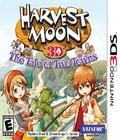If there is one thing that can be counted on from Natsume, it is that there is always another Harvest Moon on the way. At E3 2011, we sat down and get some hands-on time with Harvest Moon: The Tale of Two Towns, which is headed to the Nintendo 3DS and the Nintendo DS later this fall. The game features some nice tweaks to the Harvest Moon formula both in the form of new features and changes to some of the mainstays; it also makes great use of the 3DS hardware for that version of the game.
The story centers around two rival towns, one of which you pick as a residence. The town of Bluebell has a very European influence in its architecture, whereas its counterpart Konohana takes its cues from a variety of Asian themes. These two towns are separated at first, and as the plot unfolds, it is up to the player to unite them. They also differ in how well they cater to different play styles; starting off in Bluebell lets you have some grown animals and a ranch right off the bat, whereas starting in Konohana gives you some starting crops and seeds.
There are many changes to the gameplay from previous games, including weekly themed cooking contests in which villagers compete to have the best dish and win prizes. You will also get requests for various crops or items, and there is no penalty for turning them down, but if you complete them, you are rewarded. These requests usually require some diversity in their goals, and they do get more complicated over time. Thus, at the start a request may be little more than to get them any old turnip, but that isn't always the case.
While horses have been a part of the game for a long time, the addition of horse carts is a new one, and it allows the player to essentially bring along a mobile shipping cart. This plays into the more expansive outdoor environments, where constantly running back and forth from a shipping bin could take a lot out of your day. There are subtle feature additions, such as the ability to catch some bugs and fish with your hands rather than a net or fishing pole at all times. There are other, more immediately noticeable new features, such as the inclusion of irrigation trenches. These trenches can be run along crops to make watering them as simple as putting water in the trench. Fertilizer can also be spread this way, and that makes taking care of crops that much easier.
The majority of Harvest Moon gameplay is still intact, and there is certainly a lot of farming and ranching to be done. Your dog can help you herd livestock whereas your cat can help with herding your chickens, and throughout your days, you must scurry around while taking care of your crops and building your relationships with the local villagers. The ingredients you farm or find can be used to create tasty recipes in a system that seems largely the same as previous games, but now, recipes can be found in the game or unlocked.
Though the game is getting a simultaneous release on the DS as well, the 3DS is clearly the superior platform for the game. The Tale of Two Towns makes much better use of the 3DS' 24-bit color palette and 3-D effects, and it also has the Streetpass functionality, which will allow players to trade crops and other items. The game is otherwise the same, so DS owners shouldn't feel the absolute need to run out and get a 3DS, but if you already have one, the game certainly makes good use of it.
Our time with Harvest Moon: The Tale of Two Towns was impressive, and once again, Natsume has proven that it does a good job of continually adding to the game while still keeping the core of its gameplay intact. Farming addicts will appreciate the new features, which will help you get through your day and finally get some fishing done, like you've been intending since halfway through last season. Look for more information on the game as it gets closer to its Sept. 13, 2011, release date.
Greg Hale also contributed to this preview.
More articles about Harvest Moon: The Tale of Two Towns











 Konohana and Bluebell villages were once the friendliest of neighbors.
Then a huge dispute erupted between them.over FOOD! Both towns were certain that their cooking was the best in the world. This feud has transformed these happy neighbors into bitter rivals.
Konohana and Bluebell villages were once the friendliest of neighbors.
Then a huge dispute erupted between them.over FOOD! Both towns were certain that their cooking was the best in the world. This feud has transformed these happy neighbors into bitter rivals.

































